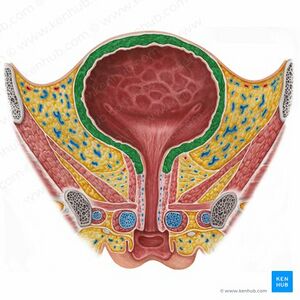Detrusor Sphincter Dyssynergia: Difference between revisions
(Created page with "== Introduction ==") |
No edit summary |
||
| Line 1: | Line 1: | ||
== Introduction == | == Introduction == | ||
According to the International Classification of Syndromes (ICS), detrusor sphincter dyssynergia (DSD) is "the impaired coordination between detrusor and sphincter during voiding due to a neurologic abnormality".<ref>Abrams P, Cardozo L, Fall M, et al. The standardisation of terminology of lower urinary tract function: Report from the Standardisation Subcommittee of the International Continence Society. Neurourol Urodyn. 2002;21(2):167-178.</ref> | |||
During normal micturition, the detrusor muscle of the bladder and the striated smooth muscle of the urethral sphincter work synergistically. The urethral sphincter relaxes during this process, and the detrusor contracts to push the bladder's urine into the urethra. The pontine micturition centre, a specialised region in the caudal brainstem, is in charge of controlling this synergy between the detrusor muscle and the external urethral sphincter. DSD is frequently caused by disruption of the pathways between this region to the caudal portion of the spinal cord.<ref name=":0">Castro‐Diaz D, Taracena Lafuente JM. Detrusor‐sphincter dyssynergia. International Journal of Clinical Practice. 2006 Dec;60:17-21.</ref> | |||
DSD refers to an involuntary detrusor contraction that is accompanied by an involuntary external sphincter contraction. This condition prevents adequate voiding and may result in hydronephrosis, renal scarring, a low compliant and thick-walled bladder, elevated retrograde pressures in the ureter and pelvis, and terminal kidney failure. <ref name=":0" /> | |||
[[File:Deterusor muscle.jpeg|center|thumb]] | |||
For more info about the anatomy of the bladder, click [[Bladder Anatomy|here]]. | |||
== Pathophysiology == | |||
Revision as of 19:45, 29 June 2023
Introduction[edit | edit source]
According to the International Classification of Syndromes (ICS), detrusor sphincter dyssynergia (DSD) is "the impaired coordination between detrusor and sphincter during voiding due to a neurologic abnormality".[1]
During normal micturition, the detrusor muscle of the bladder and the striated smooth muscle of the urethral sphincter work synergistically. The urethral sphincter relaxes during this process, and the detrusor contracts to push the bladder's urine into the urethra. The pontine micturition centre, a specialised region in the caudal brainstem, is in charge of controlling this synergy between the detrusor muscle and the external urethral sphincter. DSD is frequently caused by disruption of the pathways between this region to the caudal portion of the spinal cord.[2]
DSD refers to an involuntary detrusor contraction that is accompanied by an involuntary external sphincter contraction. This condition prevents adequate voiding and may result in hydronephrosis, renal scarring, a low compliant and thick-walled bladder, elevated retrograde pressures in the ureter and pelvis, and terminal kidney failure. [2]
For more info about the anatomy of the bladder, click here.
Pathophysiology[edit | edit source]
- ↑ Abrams P, Cardozo L, Fall M, et al. The standardisation of terminology of lower urinary tract function: Report from the Standardisation Subcommittee of the International Continence Society. Neurourol Urodyn. 2002;21(2):167-178.
- ↑ 2.0 2.1 Castro‐Diaz D, Taracena Lafuente JM. Detrusor‐sphincter dyssynergia. International Journal of Clinical Practice. 2006 Dec;60:17-21.







